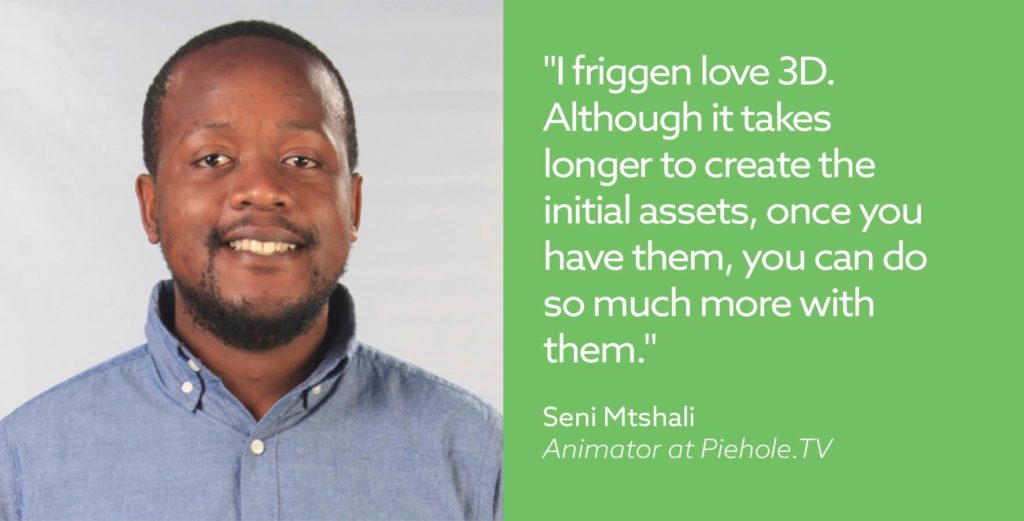We love making awesome 3D explainer videos and it’s one area that’s really hotting up. Brands are looking to create cooler and cooler content, and 3D explainer videos offer one way to do that. What are the benefits of making a video in 3D? Because you have more range of motion it can help make things look more dynamic and visually engaging. Certain scripts/products/concepts lend themselves naturally to it. So basically the answer is they look cool and they can help your message have more impact.
Here’s what one of our 3D animators has to say about it:

Just one little problem…. aren’t they expensive?
Well, they can be, but not as much more as you might think. It does tend to take more work to make 3D explainer videos but with clever scripting and design, the pricing can be kept under control. See further below for more thoughts about that.
Let’s look at some options.
3D Motion Design
In this style, we use moving graphics rather than animated characters. It’s great if you want a professional look that’s not too cartoony. It can also be easier to execute than a video with complex 3D characters.
Here below are have a style that has a more “realistic” look in the sense that the elements like the desk, plants, etc have a certain realism.
3D Motion Design – Techy
We think that 3D motion graphics are a great way to make something look super techy and cool. It makes stuff like data flows, electronics and so forth look great.
3D Motion Design – Fun
It’s also possible to make 3D explainer videos that are a bit more playful and colorful, like in the below video.
3D in a Flat 2D World
This video below uses extensive 3D but it’s used in 2D space.
Spicing up a 2D Video
Incorporating little bits of 3D is a great way to spice up a 2D animation. This adds some visual variety and can give a video a nice dynamic feel. The below video uses some 3D in the rotating turntable and some other parts. This type of approach is also more affordable than going the whole hog.
Here’s another example. It uses 3D in the intro and later again in the engine scene.
Realistic 3D Product Videos
Sometimes you want something to look exactly like the real deal. That’s where a realistic product rendering comes in. Your reason for using animation rather than live action might be cost, or to show your product in an interesting imaginary environment, like in the video below.
When making a real product demo it’s common to use the engineering/CAD drawings of the product. These are usually easily imported into the animation software and the advantage of using the design files like this is that it ensures complete accuracy and can help reduce modeling time.
Creating 3D explainer videos is also a good way to show a product that’s still in development, or if you don’t want to show something that kind of looks like the product but is not 100% accurate. The reasons for that might be privacy or IP concerns. It’s also great for modeling things like machines and industrial processes.
You may even consider creating a 3D animation of your software product. Below is an example where we created 3D animated software demo. In this specific video, you will see 3D screens, 3D moving backgrounds, and a lot of colors!
3D Character Animation
This kind of style can be great for brand storytelling (see our article here). Designing, rigging, and animating characters in 3D can be really time-consuming work. To prevent things from getting out of control it’s important to have a solid review process, with clients committing to the signed-off stages and especially a lot of attention being paid to the scripting and storyboarding so there are no unwelcome surprises later. The below video took several months to complete (almost 800 hours of animation time) and around 725 hours of rendering across a bank of 5 computers.
Production-related Considerations
To get maximum creativity for your buck the script and concept are very important. For example, by scripting in fewer visuals, you can turn these into “hero” shots that look cooler and don’t put the animation team under pressure unnecessarily. Creating good-looking visuals for their own sake is pointless, so it’s important that the scripted visuals are emphasizing the messaging goals. If things are going wrong with a project, what seems to the untrained eye to be an animation problem can often be traced to scripting issues, and that’s equally true for 3D explainer videos as for any other style of video. With 3D, every extra item that needs to be modeled will add time and this can detract from your overall quality if you’re not careful.
Your timeline is an important consideration with 3D explainer videos. It’s important to start early and not leave things to the last few weeks. Sometimes clients will lose precious days and weeks making a decision, not realizing that every half-day can make a big difference to the overall quality on a tight deadline. This brings us to our next topic.
Using your Product Engineering Diagrams
In general it’s possible to import product engineering diagrams, e.g. from Autocad, into most animation software. A popular choice for animation software of 3d explainer videos is Cinema4D. Sometimes things need a bit of tweaking but having good product designs makes for a good start to any 3D product animation project.
3D Videos on Tight Turnaround
By their nature, 3D videos are more time-consuming to create. But by being smart with your script it’s possible to create a good video in a short timeframe. For example, by eliminating unnecessary visuals you can reduce the amount of modeling needed. It can also help to choose a style that’s less computationally intensive because if you’re waiting 2 days per render then you lose a lot of time during feedback rounds. This video below was made in a short timeframe.
Price of 3D Explainer Video
If you shop around you’ll see prices ranging from $2,000 to $200,000 and a huge variation in quality too. That makes sense in the context of the process. A high-end video will take teams of talented people many weeks to create, whereas a simple one can be bashed out by one person in much less time. Most real-life businesses with solid marketing budgets will spend somewhere in the $5,000 to $30,000 range, while big B2C brands will often be the ones spending well in excess of this for Disney’esque creations.
So are 3D Explainer Videos a Thing Yet?
Yes, some of the best high-end videos these days include 3D elements. People are definitely waking up to the possibilities. These videos are also becoming more accessible to regular businesses as companies such as ourselves grow in capability.
Would you like to discuss your project? Get in touch now.
